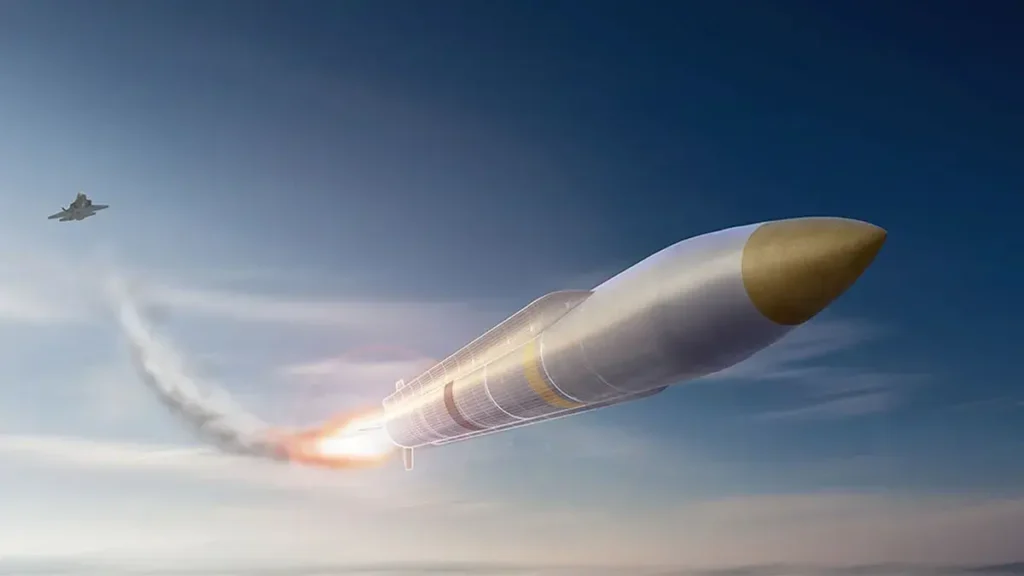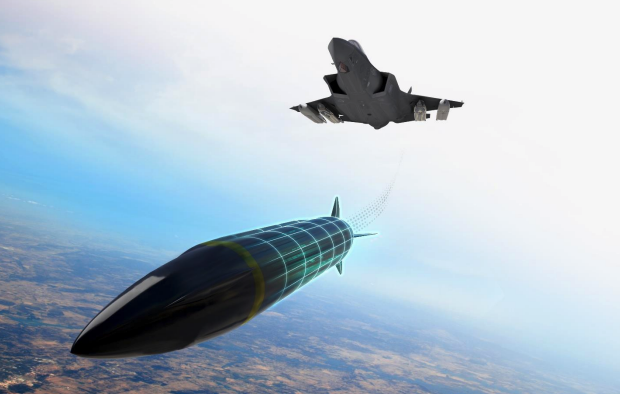America’s new precision strike missile has China in its crosshairs
- By Alex Hollings
Share This Article

In September, Northrop Grumman announced that it had secured a contract from the Air Force to move forward with a new high-speed air-to-ground missile meant to be carried internally by America’s growing fleets of stealth fighters and bombers. This new missile, dubbed the Stand-in Attack Weapon (SiAW), is meant to lead the way in high-end conflicts with modern adversaries like China, rapidly engaging a variety of ground targets deep inside hotly contested airspace from extended ranges.
The new SiAW missile is being built upon the basic structure of the Navy-led Advanced Anti-Radiation Guided Missile-Extended Range (AARGM-ER) program – the long-range radar hunting missile developed to be deployed by carrier-based F-35Cs. In fact, it appears the Air Force’s new SiAW missile may leverage a number of the same internal systems, as well as the same external dimensions.
As noted aviation journalist Tyler Rogoway posited all the way back in 2018, basing the SiAW missile on the AARGM-ER makes good practical sense for a number of reasons. The missile was designed to be carried inside the F-35C’s internal weapons bay and, unlike previous anti-radiation missiles that hone in on electromagnetic radiation alone, boasts an advanced guidance system that allows it to continue closing with enemy radar arrays even after they’ve powered down. As a result, the Air Force’s effort doesn’t need to reinvent any wheels. Instead, the $705 million contract awarded to Northrop Grumman can focus on tailoring the weapon’s capabilities specifically to the Air Force’s broader goals for the SiAW.
Air Force officials are aiming to have this new weapon reach its initial operating capability by 2026, which means the new SiAW missile is clearly on the fast track to service.
Related: Lasers won’t save us from hypersonic weapons
America’s need for longer-reach in the Pacific

The Air Force kicked off its Stand-in Attack Weapon development cycle back in January 2020 with a request for information (RFI) to industry partners for a new air-to-ground weapon specifically meant to be carried in the internal weapons bay of the branch’s runway queen (conventional take-off and landing) F-35A. Right from the get-go, one could argue the Air Force had Chinese targets in mind, highlighting the need “to hold at risk surface elements of the A2/AD environment” in the RFI.
That A2/AD acronym, which translates to Anti-Access/Area Denial, could really be attributed to any hotly contested near-peer battlefield, but the term itself is commonly used in reference to China’s approach to fortifying its sovereignty claims over vast swaths of the Pacific Ocean in recent years. This strategy includes the fielding of advanced air defenses, anti-ship weapons, anti-satellite measures, and a rapidly expanding Naval armada made up of the largest standing Navy on the planet, a rapidly growing and militarized coast guard, maritime militia, and even fleets of large-hulled fishing vessels that all fall within the country’s military command structure.
China’s A2/AD methodology pivots largely on a variety of long-range anti-ship missiles designed specifically to keep American aircraft carriers at bay. Weapons like the hypersonic DF-ZF boost-glide missile, which is carried aloft by China’s medium-range DF-17 ballistic missile, have a claimed range of nearly 1,200 miles, and an alleged top speed ranging somewhere between Mach 5 and Mach 10. With the ability to carry large conventional or even nuclear payloads combined with the sheer kinetic force of a hypersonic impact, the DF-ZF may potentially have the power to render even America’s Nimitz and Ford-class supercarriers inoperable with a single strike.

The DF-ZF creates significant challenges for American power projection, as its claimed range of nearly 1,200 miles is nearly twice the combat radius of America’s longest-flying carrier fighter, the F-35C. With about 37% more wing area than the rest of the Joint Strike Fighter family, the F-35C has a combat radius of nearly 690 miles – 510 miles short of China’s hypersonic reach. Put simply, this means sailing one of America’s carriers close enough to China to launch F-35 sorties also means placing that carrier squarely within reach of China’s carrier-killing missiles.
However, the United States Navy has taken a multi-faceted approach to offset this strategic shortcoming, with the highest profile effort arguably being its work on a 6th-generation stealth fighter – currently dubbed F/A-XX – that is intended to offer greater range and larger payloads. Other efforts include fielding carrier-based drone refuelers and operating Marine Corps F-35Bs from more distributed amphibious assault ships.
But American airpower isn’t solely a naval enterprise, and the U.S. Air Force would undoubtedly play a pivotal role in a Pacific conflict. And that’s precisely where the new SiAW missile comes into play.
Related: How F-16s will make the radar-hunting missiles of Ukraine far more capable
Giving the Air Force a stealthy long-range punch

The new Stand-in Attack Weapon (SiAW) may be based directly on the Navy’s radar-hunting AARGM-ER, but this new weapon will be going after a much wider variety of targets than enemy surface-to-air missile systems. In fact, there’s a chance these weapons could provide the Air Force with a vital means of eliminating portions of China’s area defense systems in the early stages of conflict, clearing the way for carriers to sail closer to Chinese shores without risking being sunk.
According to the Air Force’s budget request for Fiscal Year 2020: “The Stand In Attack Weapon (SiAW) system will provide strike capability to defeat rapidly relocatable targets that create the Anti-Access/Area Denial (A2/AD) environment. The target environment includes Theater Ballistic Missile Launchers, Land Attack and Anti-Ship Cruise Missile Launchers, GPS Jammers, Anti-Satellite Systems, and Integrated Air Defense Systems.”
In essence, the SiAW is envisioned as a means to engage just about any stationary or moving target on the ground or even at sea, leveraging its multi-mode guidance capabilities to that end. The SiAW will carry a different warhead and fuse than the AARGM-ER, but appears to boast the same GPS-assisted inertial navigation system and millimeter-wave radar seeker. That means these missiles can close with pre-programmed targets, even in GPS-denied environments, or identify targets within a set area to engage. In the AARGM-ER, this capability allows the missile to continue chasing after enemy radar arrays even after they power down – by first identifying the array and then using its inertial and GPS navigation to close with its last broadcast location. The millimeter wave radar seeker can even allow it to close with moving targets within the target area.

If target information changes while the missile is already in flight, a two-way data link allows the launching aircraft (or other nearby assets) to update the weapon with new target coordinates on the spot.
Because of its advanced guidance system, the weapon can even be launched toward a set area more or less “blind,” or within a specific intended target in mind. As it flies, it can receive new target information from offboard sensors, identifying a target while in flight and then closing with it on land or sea, even if it’s moving.
When combined with the advanced sensor suite of the F-35A, the SiAW will offer a single weapon that can address a wide variety of surface threats. Its overall range – and that of the AARGM-ER – remain undisclosed, but previous claims have suggested that it will offer an increase in range from 20% to even 50% over the AGM-88E it’s set to replace. This would give the SiAW and its AARGM-ER sibling a range of somewhere between 96 and 120 miles.
The AARGM-ER is approximately 13 feet, four inches long, with an 11.5-inch wingspan and around 1,030 pounds. Despite carrying some slightly different hardware, the SiAW is expected to be about the same, as it too will need to be stowed inside the F-35’s cramped interior.
Related: The Marines’ new drone-truck can take out enemy ships from 1,000 miles away
How the SiAW and AARGM-ER could have a huge effect in the Pacific

F-35As and F-35Cs carrying a combination of ARRGM-ERs and new SiAWs could play a pivotal role in a Pacific conflict, engaging a wide variety of air defense and anti-ship targets from stand-off ranges, well outside the reach of even the most advanced and modern air defense systems.
Russia’s S-400 Triumf surface-to-air missile systems are widely considered to be among the most capable on the planet, despite their recent poor performance in Ukraine. To that end, China first secured a contract to purchase these systems from Russia in 2014, with the second complete system arriving in 2020.
According to a peer-reviewed assessment by Hellenic Air Force Colonel and electronics engineer Konstantinos Zikidis, published by the Journal of Computations & Modelling in 2014, Russia claims the low-frequency arrays leveraged by the S-400’s Nebo-M radar array can detect the F-117 Nighthawk at a range of 350 kilometers (217 miles) in an environment free from electronic warfare (EW), and potentially as far as 72 kilometers (45 miles) under heavy jamming. This serves as the basis for the S-400’s counter-stealth claims.

However, low-frequency arrays are not capable of securing a weapon’s grade lock. In other words, they don’t have the image fidelity to guide a weapon into a target. Instead, the low-frequency array serves as a guide for a higher-frequency targeting array, potentially speeding up the targeting process once a stealth aircraft flies close enough for it to produce a high-frequency return.
The F-35 has a publicly disclosed radar cross-section of about half the size of the F-117 Nighthawk, which could potentially double those disclosed detection ranges (depending on the angle of observation and a number of other variables). Based on publicly available data, an F-35 would likely need to fly within 20 miles of the S-400 system in order to be targeted.
With the AARGM-ER’s range likely to be between 96 and 120 miles, this means the F-35 could effectively engage China’s most advanced air defense systems from as much as 100 miles outside their targeting envelope. But, despite this significant advantage, there’s still the issue of getting enough land and sea-based F-35s into range of these systems to take them out. Luckily, America has another stealth platform heading for service that comes with plenty of range and payload capacity to spare: the B-21 Raider.
Related: The S-400 Myth: Why Russia’s air defense prowess is exaggerated
B-21 Raiders carrying AARGM-ERs and SiAWs makes for a serious one-two punch

In the U.S. Air Force’s budget proposal for Fiscal Year 2018, the branch outlined intentions to integrate the Stand-in Attack Weapon (SiAW) into the B-21 Raider – America’s new stealth bomber in active development. With a projected payload capacity of 30,000 pounds or better, the B-21 could potentially carry dozens of SiAWs and AARGM-ER missiles on rotary launchers similar to those employed by the in-service B-2 Spirit.
The B-21’s actual range has yet to be revealed, but Defense officials have already begun touting it as unmatched in the world.
“Let’s talk about the B-21’s range. No other long-range bomber can match its efficiency. It won’t need to be based in-theater. It won’t need logistical support to hold any target at risk,” Defense Secretary Llyod Austin has said. Its predecessor, the B-2 Spirit, boasts an unrefueled range of 6,000 nautical miles (more than 6,900 miles or 9,600 kilometers), and it stands to reason that the B-21 will be able to exceed even that. As a result, America’s intended fleet of more than 100 B-21 Raiders could play a pivotal role in clearing a path for American carriers to close with Chinese shores by flying initial strikes against anti-ship and integrated air-defense systems, engaging hundreds of targets on land and sea with SiAW and AARGM-ER missiles.
Because of the wide array of targets these weapons can engage, B-21 pilots could make tactical decisions in theater regarding which systems to prioritize for their own self-defense as well as for optimal mission accomplishment. And because the B-21 was designed to be optionally manned, these sorties may not even require putting pilots at risk.
By launching this sort of attack in conjunction with other programs, like Rapid Dragon – which would allow cargo aircraft like the C-130 and C-17 to launch dozens of low-observable and long-range cruise and anti-ship missiles from 500 miles out – the United States could lay waste to a large portion of China’s shoreline defenses in short order. With the path cleared for American carriers to sail closer to Chinese territory, more suppression of air defense operations would follow until the airspace became permissive enough for less stealthy platforms to join the fight in a more active way.
But… this approach to warfare is an expensive one, and it’s important to understand the difference between plans and reality.
Related: Iran claims to detect F-35s over the Persian Gulf. Here’s why they can
Deterring wars, over winning them

Exploring the ways in which these advanced technologies could give the United States a strategic edge in a large-scale conflict with an opponent like China may paint a rosy picture, but the harsh realities of warfare never live up to our most optimistic expectations. Ultimately, even if the United States manages to field and mass-produce these advanced platforms and weapons in sufficient volume to mount such an offensive, losses are all but certain. Stealth is not invisibility, aircraft and weapons are rarely (if ever) leveraged at maximum ranges, and even advanced systems are prone to fail amid the extreme rigors of combat.
And while this approach could give the United States the advantage in such a conflict, China’s massive military footprint would still present enormous challenges for the American military. In other words, at best, this approach could amount to an incredible opening volley; the war that would follow would be costly for both nations at a scale the world has not seen since the end of World War II.
Therefore, it’s vital to remember that the most valuable use for new weapons like the SiAW, AARGM-ER, and even the stealth aircraft that will carry them isn’t in winning a war. Instead, their best return on investment comes from deterring such a conflict from happening in the first place.
And therein lies the reason Uncle Sam is happy to reveal these developmental efforts, why new fighters and bombers get product-reveals like a new iPhone, and why there’s so much information about America’s military capabilities in the public’s hands. A secret weapon has no strategic value until blood is already being shed, but a disclosed one has the unique power to prevent bloodshed without ever being fired.
Ultimately, there could be no better outcome for all the incredible engineering that goes into weapons like the Stand-in Attack Weapon than never actually having to take it off the shelf.
Read more from Sandboxx News
- 300 million bullets and counting: America’s military aid to Ukraine
- How serious are ‘War Thunder’s’ classified document leaks?
- Complete the mission or follow the rules? Air Force tests AI in flight experiment
- The Navy SEALs’ two original and little-known missions
- The US Intelligence Community has a new strategy for the future
Related Posts
Sandboxx News Merch
-

‘AirPower’ Classic Hoodie
$46.00 – $48.00Price range: $46.00 through $48.00 Select options This product has multiple variants. The options may be chosen on the product page -

‘Sandboxx News’ Trucker Cap
$27.00 Select options This product has multiple variants. The options may be chosen on the product page -

‘Kinetic Diplomacy’ Bumper Sticker (Black)
$8.00 Add to cart

Alex Hollings
Alex Hollings is a writer, dad, and Marine veteran.
Related to: Airpower, Gear & Tech

How Colombia’s drug cartels almost bought a Soviet submarine

How much does it cost to train an Air Force pilot? A LOT

The untold history of the Soviet Union’s weapons testing in space

Iconic Black Hawk helicopter has been turned into a drone
Sandboxx News
-

‘Sandboxx News’ Trucker Cap
$27.00 Select options This product has multiple variants. The options may be chosen on the product page -

‘AirPower’ Classic Hoodie
$46.00 – $48.00Price range: $46.00 through $48.00 Select options This product has multiple variants. The options may be chosen on the product page -

‘AirPower’ Golf Rope Hat
$31.00 Select options This product has multiple variants. The options may be chosen on the product page -

‘Sandboxx News’ Dad Hat
$27.00 Select options This product has multiple variants. The options may be chosen on the product page
